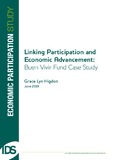Linking Participation and Economic Advancement: Buen Vivir Fund Case Study
| dc.contributor.author | Higdon, Grace Lyn | |
| dc.date.accessioned | 2019-06-14T09:27:48Z | |
| dc.date.available | 2019-06-14T09:27:48Z | |
| dc.date.issued | 2019-06-14 | |
| dc.identifier.citation | Higdon, G.L. (2019) Linking Participation and Economic Advancement: Buen Vivir Fund Case Study, Brighton: IDS | en |
| dc.identifier.isbn | 978-1-78118-562-9 | |
| dc.identifier.uri | https://opendocs.ids.ac.uk/opendocs/handle/20.500.12413/14534 | |
| dc.description.abstract | The Buen Vivir Fund is a participatory impact investment fund operating internationally. It was founded in 2018 by Thousand Currents, a non-governmental organisation, following a co-design process to conceptualise the Fund, initiated in late 2016. The Buen Vivir Fund has intentionally started small in terms of volume of capital, having raised US$1m in loan capital for its initial investment cycle in 2018–20. This US$1m, plus US$300,000 raised in grant capital, is being deployed with the guidance of the Fund’s Members Assembly, which is the governing body comprised of ten grass-roots organisations from Asia, Africa, and Latin America, and eight institutional investors, primarily foundations. Over the next five years, the Buen Vivir Fund is poised to expand its membership to 30–50 and increase its investments to US$5m. Now in its second year, the Fund is fully operational having recently completed its first round of loan disbursal. To date, the Buen Vivir Fund has linked US$427,700 in loan capital to US$113,000 of grant capital across nine projects led by grass-roots community organisations in Latin America, North America, Southern Africa, and South Asia. These grass-roots organisations have each developed entrepreneurial, micro-lending and community-driven, sustainable wealth-sharing practices proven effective in their local contexts. The Buen Vivir Fund applies these effective grass-roots economic practices to the level of a global investment fund, and it brings together financial investors and grass-roots organisational leaders as peers and fellow Fund members. The Fund promotes a financial model that seeks to be transformative, not transactional, by broadening the definitions of return to include communities’ holistic wellbeing, while avoiding the traditional focus on maximising capital accumulation. The Buen Vivir Fund employs a participatory approach such that investors and grass-roots representatives have equal voting rights in the governance and management of the Fund through its Members Assembly, and loan terms shift risk away from the grass-roots investees who make a solidarity contribution of their choosing based on the rate of growth and success of projects. | en |
| dc.description.sponsorship | Open Society Foundations | en |
| dc.language.iso | en | en |
| dc.publisher | IDS | en |
| dc.rights | This is an Open Access case study distributed under the terms of the Creative Commons Attribution Non Commercial 4.0 International licence (CC BY-NC), which permits use, distribution and reproduction in any medium, provided the original authors and source are credited, any modifications or adaptations are indicated, and the work is not used for commercial purposes. http://creativecommons.org/licenses/by-nc/4.0/legalcode | en |
| dc.rights.uri | http://creativecommons.org/licenses/by-nc/4.0/ | en |
| dc.subject | Economic Development | en |
| dc.subject | Governance | en |
| dc.subject | Participation | en |
| dc.title | Linking Participation and Economic Advancement: Buen Vivir Fund Case Study | en |
| dc.type | Series paper (IDS) | en |
| dc.rights.holder | © Institute of Development Studies 2019 | en |
| dc.identifier.team | Business, Markets and the State | en |
| rioxxterms.funder | Default funder | en |
| rioxxterms.identifier.project | Default project | en |
| rioxxterms.version | VoR | en |
| rioxxterms.funder.project | 9ce4e4dc-26e9-4d78-96e9-15e4dcac0642 | en |
Files in this item
This item appears in the following Collection(s)
Except where otherwise noted, this item's license is described as This is an Open Access case study distributed under the terms of the Creative Commons Attribution Non Commercial 4.0 International licence (CC BY-NC), which permits use, distribution and reproduction in any medium, provided the original authors and source are credited, any modifications or adaptations are indicated, and the work is not used for commercial purposes. http://creativecommons.org/licenses/by-nc/4.0/legalcode


